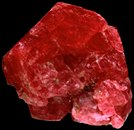|
|
| Formula: | Al2O3 |  Click to see a larger image |
||
| Crystal: | Hexagonal | |||
| Hardness: | 9 | |||
| Spec. Gr.: | 4.0-4.1 | |||
| Streak: | Uncolored | |||
| Cleavage: | none | |||
| Location: | Mogok, Myanmar (Burma) |
| Ruby is one of the rarest and most valuable of all gemstones. It is the red member of the corundum family, and as such is a very hard (9), has a high glass-like luster, and is colored by a trace amount of chromium. A flawless, deep colored ruby of more than five carats is extremely rare and is quite valuable. The finest red-colored rubies have been called "pigeon's-blood." The best rubies come from Sri Lanka, Thailand, Cambodia, and especially Mogok and Mong Hsu, Myanmar (formerly Burma). Rutile needle-shaped crystals may form in a ruby. When light is reflected on the needles the result may be a diffused "sheen" or asterism, and the six-fold symmetry of corundum produces a six-rayed star. The finest star ruby is the 138 caret Rosser Reeves star ruby displayed in the Smithsonian Institution. During the middle ages, alchemist physicians prescribed it as an antidote to venom and a cure for plague, and when placed on a wound, it was supposed to stop bleeding. |
|
Bibliography: Alain, Eid, Minerals of the World, pg. 103. Arem, Joel, Gems and Jewelry, 1975, pg. 50-55. |
|
University of California, Santa Barbara—Department of Earth Science Copyright © 2005 Regents of the University of California Send your comments to the Web Page Editor |